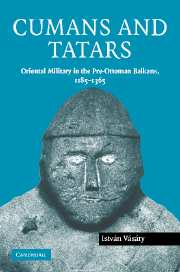Book contents
- Frontmatter
- Contents
- Preface
- 1 Introduction
- 2 Cumans and the Second Bulgarian Empire
- 3 Cumans in the Balkans before the Tatar conquest, 1241
- 4 The first period of Tatar influence in the Balkans, 1242–1282
- 5 The heyday of Tatar influence in the Balkans, 1280–1301
- 6 Cumans and Tatars on the Serbian scene
- 7 Cumans in Byzantine service after the Tatar conquest, 1242–1333
- 8 The Tatars fade away from Bulgaria and Byzantium, 1320–1354
- 9 The emergence of two Romanian principalities in Cumania, 1330, 1364
- Conclusion
- Appendix 1 List of geographical names
- Appendix 2 Chronological table of dynasties
- Appendix 3 Maps
- List of abbreviations
- Bibliography
- Index
7 - Cumans in Byzantine service after the Tatar conquest, 1242–1333
Published online by Cambridge University Press: 29 July 2009
- Frontmatter
- Contents
- Preface
- 1 Introduction
- 2 Cumans and the Second Bulgarian Empire
- 3 Cumans in the Balkans before the Tatar conquest, 1241
- 4 The first period of Tatar influence in the Balkans, 1242–1282
- 5 The heyday of Tatar influence in the Balkans, 1280–1301
- 6 Cumans and Tatars on the Serbian scene
- 7 Cumans in Byzantine service after the Tatar conquest, 1242–1333
- 8 The Tatars fade away from Bulgaria and Byzantium, 1320–1354
- 9 The emergence of two Romanian principalities in Cumania, 1330, 1364
- Conclusion
- Appendix 1 List of geographical names
- Appendix 2 Chronological table of dynasties
- Appendix 3 Maps
- List of abbreviations
- Bibliography
- Index
Summary
THE CUMANS IN THE WARS OF THEODOROS II, MICHAEL VIII AND ANDRONIKOS II
As we saw in Chapter 3, on the eve of the Mongol invasion Cuman troops were settled in different parts of the Byzantine Empire, both in Thrace and Macedonia, and in Asia Minor. The Cumans were used by the Byzantines in two capacities: as reserve light cavalry and as standing troops. The emperor John III (Doukas Batatzes) called them to arms as light cavalry on every possible occasion, and his successors after 1254 followed him in their dealings with the Cumans. We shall now briefly review the Cumans' presence in Byzantine military actions after the Tatar invasion. In 1242 the Cumans came to Thessalonike to assist Batatzes in his siege of Thessalonike. In 1256 Theodore II Laskaris left a contingent of 300 Cumans and Paphlagonians with the governor of Thessalonike. In 1259, 2,000 Cuman light cavalry fought in the battle of Pelagonia. In 1261, the bulk of Alexios Strategopoulos' troop of 800 men who took part in Constantinople's recapture were Cumans. In 1263–4, 1270–2, and 1275 considerable Cuman contingents fought in Michael VIII's European campaigns. The last mention of the Cumans, when they were settled in Byzantium by Batatzes, occurs in 1292; during Andronikos II's abortive campaign in Epeiros the undisciplined forces of the Cumans and Turks withdrew without permission.
- Type
- Chapter
- Information
- Cumans and TatarsOriental Military in the Pre-Ottoman Balkans, 1185–1365, pp. 114 - 121Publisher: Cambridge University PressPrint publication year: 2005

